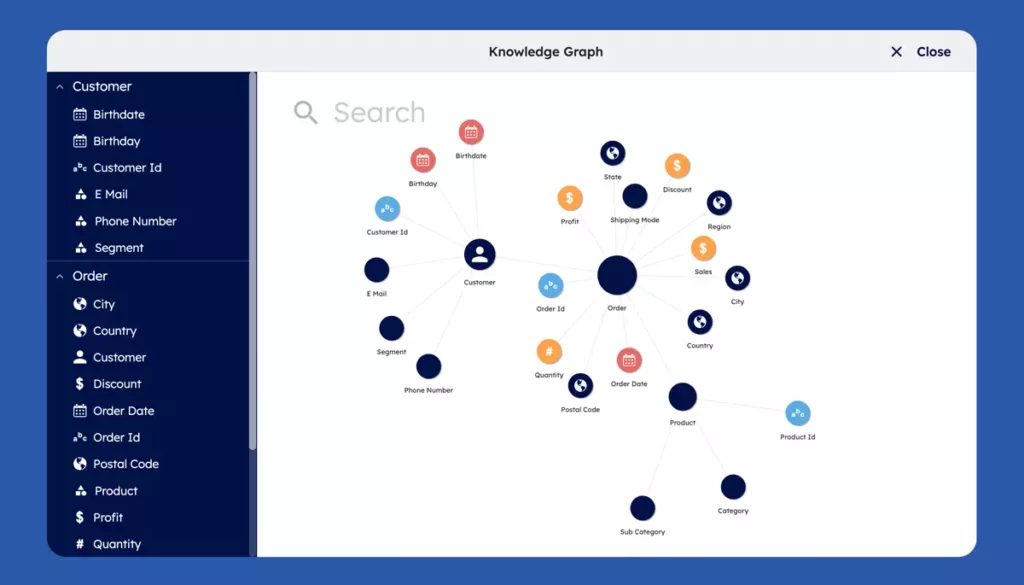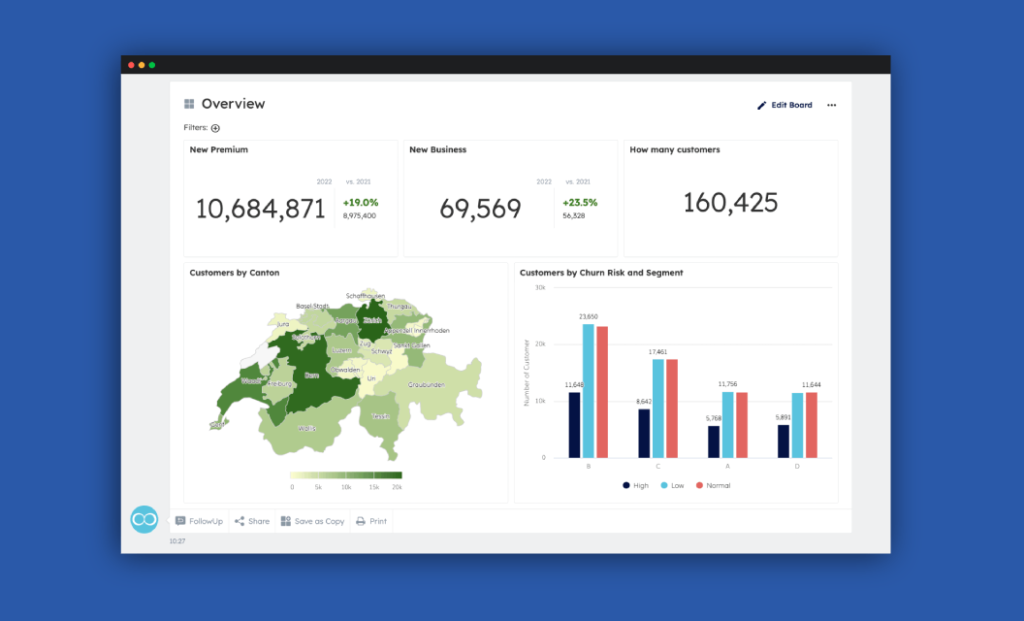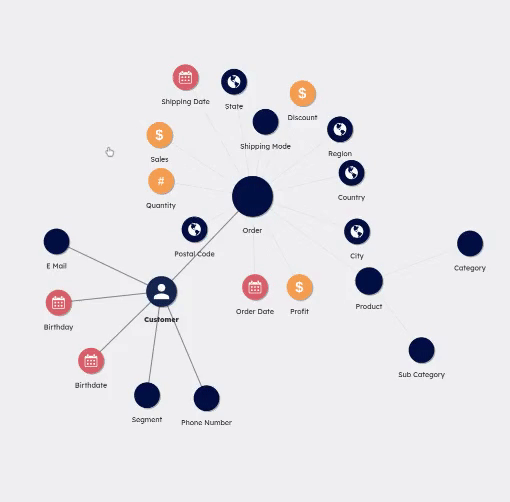How LLMs and Semantic Layers Are Revolutionising Self-Service Analytics
When it comes to Self-Service Analytics, two key features have emerged as real game-changers - Semantic Layers and LLMs. But what exactly are these and why should you, as a data enthusiast, care about them?

When it comes to Self-Service Analytics, two key features have emerged as real game-changers – Semantic Layers and LLMs. But how do they work together and why should you, as a data enthusiast, care about them?
Let’s start with the basics — a Semantic Layer. Imagine it as a universal translator (like in your favorite sci-fi films) but for data. It interprets complex databases and technical data structures into simple, easily understood language. It bridges the gap between raw data and the realization of business intelligence.
On the other hand, LLMs are sophisticated machine-learning models that can understand, generate, and respond to human language. It’s like chatting with a remarkably clever machine that understands and responds to you just like a fellow human would.
When you combine Semantic Layers with LLMs, it’s like unlocking a secret level in the data science game. The Semantic Layer’s data translation melds seamlessly with the LLM’s language comprehension capabilities, leading to a powerful tool for personalized and accurate data exploration. It’s a match made in (computational) heaven that could pave the way for revolutionizing Self-Service Analytics.
The implications of this dynamic duo are enormous. They have the potential to shape the future of data analytics and business intelligence, making these fields more accessible and user-friendly than ever. Imagine a world where a sales manager has an overview of every customer portfolio across all verticals without having to request a single dashboard.
That’s the sort of reality that it can create within your company. This isn’t just another hype – it’s an industry game-changer.
Charting the Course of Self-Service Analytics
To truly appreciate the power of this Semantic Layer and LLM combo, let’s take a little trip down memory lane.
Remember when we depended solely on static dashboards, constantly refreshing them, hoping for fresh insights, or perhaps new answers? It was both tedious and not very rewarding.
Well, thanks to the evolution of technology, we managed to upgrade to interactive Business Intelligence (BI) tools, creating a more dynamic journey in the realm of data analytics.
Fast forward to today; we’ve seen some groundbreaking advancements. Take Snowflake and Veezoo, for instance. We are in a whole new era of data management and exploration. Snowflake lets companies store and analyze data using cloud-based hardware, making data queries faster and smoother. Veezoo, on the other hand, is a robust Self-Service Analytics solution, empowering business users to analyze and explore their data with ease.
But the revolution doesn’t stop there. The onset of these technologies signals a move towards an age of unrestricted data exploration. It’s no longer just about viewing and modifying static dashboards or limited BI explorations. We’re looking at a future where unrestricted data exploration or, in other words, data democratization, is the norm.
By building on these modern technologies, Semantic Layers and LLMs have the potential to totally reshape the future of work.

LLMs Alone Can’t Get The Job Done
Now, let’s dive deeper into the world of Large Language Models (LLMs). It’s safe to say there’s been quite a whirlwind of excitement (think ChatGPT!) around these, with hype growing at an exponential rate. These language models are nothing short of groundbreaking when it comes to their impact on the Business Intelligence (BI) industry.
LLMs bring language comprehension abilities that were previously unseen. They have the impressive ability to distill user intent into actionable insights and responses – undeniably transformative progress in this space.
However, even the most intelligent machines have their weak spots. The common challenge faced when leveraging LLMs for BI analytics lies in their contextual understanding – more specifically, their understanding of business-specific context. For instance, terms like “revenue” or “active users” may have unique interpretations depending on the nuances of your business. If not adequately trained or without access to this specific context, LLMs can overlook these unique definitions, leading to less accurate representations of data.
The potential for misinterpretation by LLMs is not merely a theoretical risk, but it can have very real consequences for businesses. Let’s look at an example. Suppose “revenue” in your company’s context includes a certain type of discount, but the LLM, without specific business context, interprets “revenue” in its general sense. The resulting analytics could then report significantly higher revenue figures, leading to incorrect business decisions being made.
What are the consequences of this? Inaccurate data interpretation isn’t just a minor error; it can trigger a domino effect of poor strategic decisions. In some cases, it could even have legal implications, such as incorrect reporting to stakeholders.
Thus, while LLMs offer unprecedented comprehension abilities, without coupling them with a semantic layer providing the right business-specific context, their utility in Self-Service Analytics may be considerably limited.
The Semantic Layer and What It Brings to The Table
This is where we get to the crux of our discussion: the need for a Semantic Layer.
Can we imagine LLMs as skilled linguists who can translate a wide array of languages but sometimes struggle when it comes to interpreting the fine cultural nuances?
Well, the Semantic Layer can be perceived as the cultural knowledge and context that assists in refining these translations, making them more accurate. The Semantic Layer backs LLMs with context, ensuring that ‘net revenue’ or an ‘active user’ is defined precisely in the context of your business. It creates a framework that guarantees consistency and correctness, regardless of how the data is pulled or interpreted.
Imagine combining the powerful comprehension skills of LLMs with the precision that the Semantic Layer provides. This pairing harnesses the strengths of both, creating an extremely advanced analytics tool, customized to your business’s unique definitions. They complement each other, with the LLMs’ comprehension capabilities, digesting the complexity of the Semantic Layer, offering users a simple interaction experience and precision in their analytics.
Once we put these together, the result is a tool that understands natural language queries, enriched with specific business contexts. This makes your analytics tool not just a data interpreter, but a high-context analyst that works on behalf of your end users, delivering responses in seconds, not days.
The Semantic Layer’s role becomes indispensable here. It rectifies the challenges faced by the LLMs by maintaining universal definitions where accuracy is paramount. A combination of both could mean a world where self-serve is no longer just a myth but a reality within our grasp.
By delivering context-driven, accurate results instantaneously, such fusion presents a future of data analytics where complexities recede to the background and accessible data insights emerge at the forefront.
What Does Combining a Semantic Layer with an LLM Look Like For Your Business?

With a clear picture of how LLMs and the Semantic Layer can complement each other in theory, let’s shift our focus to practice. Various industries have started embracing this transformative combination, reaping significant benefits in their data analysis process.
Here are a few examples of how this benefits some workflows:
– Reducing workload on data teams: With LLMs and Semantic Layers working together, a larger number of queries can be handled swiftly and correctly. This reduces the reliance on data teams to decipher and respond to each data request, freeing them to focus on more strategic and complex tasks.
– Empowering non-technical teams: Teams that traditionally relied heavily on data scientists for analytics, such as marketing or sales, now have the tool to independently pull data and gain insights. This reduces turnaround times for data-based decisions and increases overall efficiency.
– Quick, reliable insights: With enhanced comprehension and guaranteed correctness, integrated LLMs and Semantic Layers ensure quicker, more accurate data results. This leads to improved decision-making across all departments, driven by reliable insights.
No matter the industry, the integration of LLMs and Semantic Layers is driving a fundamental shift in data analytics, transforming company workflows and boosting levels of productivity in an unprecedented manner.
This new approach is empowering businesses to generate reliable insights faster, make data-driven decisions more efficiently, and ultimately, stay competitive in an increasingly data-saturated landscape. The impact is clear: When it comes to harnessing the full potential of data analytics, the fusion of LLMs and Semantic Layers is increasingly becoming a game-changer.
In conclusion, embracing the Semantic Layer signifies stepping towards a future where businesses can engage with their data with precision, ease, and independence, solving one query at a time. With this integration, we look forward to democratizing data analytics and embarking on a journey where we can navigate the intimidating world of data like a breeze. The future of Self-Service Analytics is not just about asking the right questions but also understanding the right definitions. And that looks like a future worth writing about.


